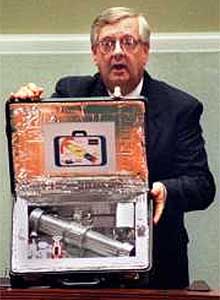
![Rep. Curt Weldon (R-Penn) holds mock-up of a hypothetical "suitcase" nuclear bomb during a hearing on Russian espionage chaired by Rep. Dan Burton (R-Indiana), 24 January 2000.•Small size (60x40x20 cm) and relatively light weight (probably upward of 30 kg). These parameters are generally consistent with available information about Soviet 152-mm artillery shells, as well as with the U.S. SADM.[19] •Low yield (less than 1 kt, maybe as low as 0.1 kt). •Remained under control of the 12th GUMO (the Main Department at MOD in charge of handling all nuclear devices), were kept at or near MOD Special Forces (Spetsnaz) bases, as well as at central storage facilities, and were intended for transfer to Spetsnaz at short notice. •Short life span between scheduled maintenance. According to the chief of the 12th GUMO, Igor Valynkin, small munitions required replacement of components every several months (other sources mentioned six months).[20] Valynkin's statement is the most direct corroboration of the allegations about the existence of portable nuclear devices. Stationary nuclear mines with such a short warranty period simply did not make sense, while portable devices for use behind enemy lines could still be acceptable. •Were likely equipped with reasonably sophisticated permissive action links (PALs), which should preclude unauthorized use. Also, there is unconfirmed information that some small nuclear devices (munitions for 152-mm howitzers) were kept during peacetime in "half-assembled" state, i.e., parts were kept separately, although quick assembly in the case of war was possible.](https://groundreport.com/wp-content/uploads/2014/10/suit.jpg)
Rep. Curt Weldon (R-Penn) holds mock-up of a “suitcase” nuclear bomb during a hearing on Russian espionage chaired by Rep. Dan Burton (R-Indiana), 24 January 2000.Characteristics: •Small size (60x40x20 cm) and relatively light weight (probably upward of 30 kg). These parameters are generally consistent with available information about Soviet 152-mm artillery shells, as well as with the U.S. SADM.
•Low yield (less than 1 kt, maybe as low as 0.1 kt).
•Remained under control of the 12th GUMO (the Main Department of the Russian MOD in charge of handling all nuclear devices), were kept at or near MOD Special Forces (Spetsnaz) bases, as well as at central storage facilities, and were intended for transfer to Spetsnaz at short notice.
•Short life span between scheduled maintenance. According to the chief of the 12th GUMO, Igor Valynkin, small munitions required replacement of components every several months (other sources mentioned six months). Valynkin’s statement is the most direct corroboration of the allegations about the existence of portable nuclear devices. Stationary nuclear mines with such a short warranty period simply did not make sense, while portable devices for use behind enemy lines could still be acceptable.
•Were likely equipped with reasonably sophisticated permissive action links (PALs), which should preclude unauthorized use. Also, there is unconfirmed information that some small nuclear devices (munitions for 152-mm howitzers) were kept during peacetime in “half-assembled” state, i.e., parts were kept separately, although quick assembly in the case of war was possible.
Each missile is tipped with multiple warheads and each warhead is anywhere from 10 to 50 times as powerful as the bomb dropped on Nagasaki and Hiroshima, Japan toward the end of WWII.
The US report is based on official figures exchanged between the two countries as part of the New START disarmament treaty, and includes missiles deployed before September 1, 2014.
The numbers show an increase from March of this year, when data showed that Washington had a capacity of 1,585 payloads, and Moscow 1,512.
Russia recently announced it would overhaul its entire nuclear arsenal by 2020, as part of a wider rearmament program that has been budgeted at $700 billion dollars.
Although Moscow has not provided a detailed breakdown of how it achieved the upgrade of nuclear capacity over the past months, experts have speculated that the increase has been due to the armament of one or two Borei-class nuclear submarines.
Note: This does not include specialized Russian nuclear weapons like nuclear “mines” and “suitcase nukes.” In the US it does not include Man packed nuclear weapons such as the Davy Crocket (AKA: The M-28 or M-29 Davy Crockett Weapon System(s) a tactical nuclear recoilless rifle (smoothbore gun) for firing the M388 nuclear projectile that was deployed by the United States during the Cold War. And rumored to still be part of America’s nuclear arsenal). Named after American soldier, congressman, and Davy Crocket it is “one” of the smallest US nuclear weapon systems ever built or designed by man).
See related article: Russia begins increased submarine patrols off the coasts of the United States https://groundreport.com/russia-begins-increased-submarine-patrols-off-the-coasts-of-the-united-states/
Note: A study presented at the annual meeting of the American Geophysical Union in December 2006 found that even a small-scale, regional nuclear war could disrupt the global climate for a decade or more. In a regional nuclear conflict scenario where two opposing nations in the subtropics would each use 50 Hiroshima-sized nuclear weapons (about 15 kiloton each) on major populated centres, the researchers estimated as much as five million tons of soot would be released, which would produce a cooling of several degrees over large areas of North America and Eurasia, including most of the grain-growing regions. The cooling would last for years, and according to the research could be “catastrophic
See article: How to survive a nuclear bomb attack! https://groundreport.com/how-to-survive-a-nuclear-bomb-attack/
See article: Russian strategic long range nuclear bombers “tested” US air defenses, according to reports https://groundreport.com/russian-strategic-nuclear-bombers-…/
